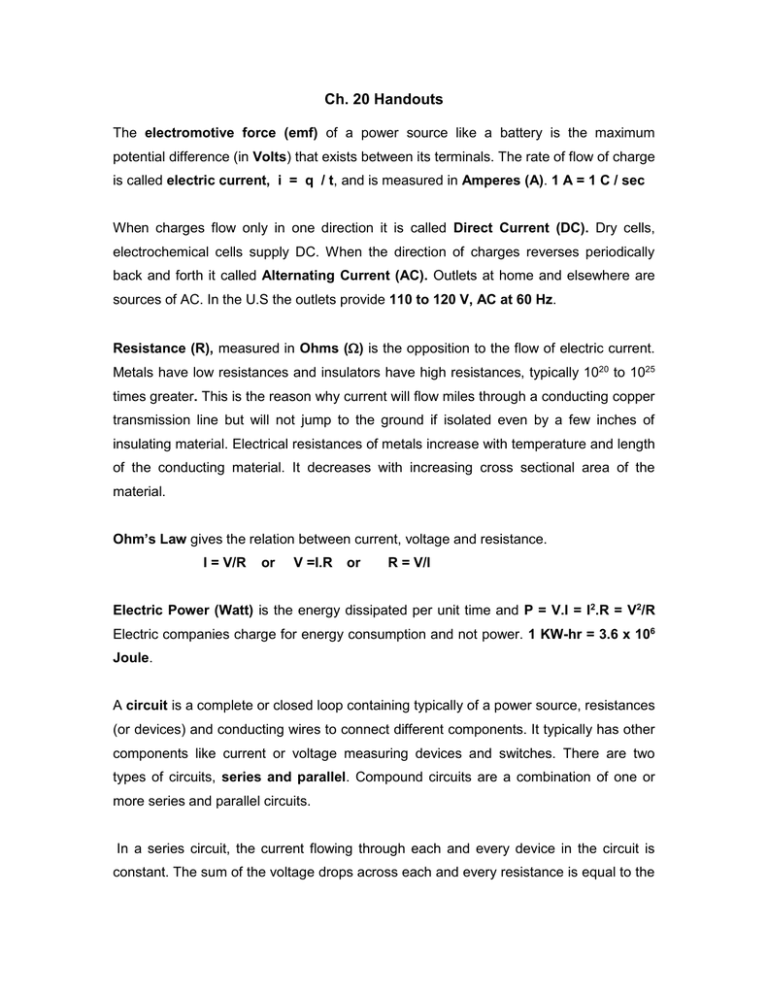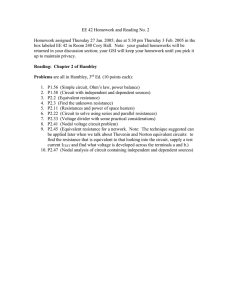Ch. 20 Handouts
advertisement

Ch. 20 Handouts The electromotive force (emf) of a power source like a battery is the maximum potential difference (in Volts) that exists between its terminals. The rate of flow of charge is called electric current, i = q / t, and is measured in Amperes (A). 1 A = 1 C / sec When charges flow only in one direction it is called Direct Current (DC). Dry cells, electrochemical cells supply DC. When the direction of charges reverses periodically back and forth it called Alternating Current (AC). Outlets at home and elsewhere are sources of AC. In the U.S the outlets provide 110 to 120 V, AC at 60 Hz. Resistance (R), measured in Ohms () is the opposition to the flow of electric current. Metals have low resistances and insulators have high resistances, typically 1020 to 1025 times greater. This is the reason why current will flow miles through a conducting copper transmission line but will not jump to the ground if isolated even by a few inches of insulating material. Electrical resistances of metals increase with temperature and length of the conducting material. It decreases with increasing cross sectional area of the material. Ohm’s Law gives the relation between current, voltage and resistance. I = V/R or V =I.R or R = V/I Electric Power (Watt) is the energy dissipated per unit time and P = V.I = I2.R = V2/R Electric companies charge for energy consumption and not power. 1 KW-hr = 3.6 x 106 Joule. A circuit is a complete or closed loop containing typically of a power source, resistances (or devices) and conducting wires to connect different components. It typically has other components like current or voltage measuring devices and switches. There are two types of circuits, series and parallel. Compound circuits are a combination of one or more series and parallel circuits. In a series circuit, the current flowing through each and every device in the circuit is constant. The sum of the voltage drops across each and every resistance is equal to the total voltage supplied by the power source. In a parallel circuit all the components are each connected to the same terminals, therefore the voltage across every branch is the same. However, current varies, being higher for low resistances and vice versa. The sum of currents through all branches is equal to the total current supplied by the power source. Series Circuit: There is a single path for current to flow. Current I is constant. Increasing the number of resistances increases the overall resistance of the circuit and decreases the current. R = R1 + R2 + R3 +……… V = V1 + V2 + V3 +……… Parallel Circuit: There are several pathways for current to flow. Voltage V is constant. Increasing the number of resistances decreases the overall resistance of the circuit and increases the total current. 1/R = 1/ R1 + 1/R2 + 1/R3 +……… I = I1 + I2 + I3 +………… A Voltmeter measures voltage and this is always measured across a resistance. A voltmeter is always placed in parallel to the device across which we wish to measure the voltage. An Ammeter measures current and current is always measured through a circuit. So an ammeter is inserted in a circuit in series at the point through which we wish to measure the current. Kirchoff’s junction rule states that the sum of currents to any junction must equal the sum of currents leaving it. Kirchoff’s loop rule states that around a closed circuit, the sum of potential drops equal sum of potential rises.




